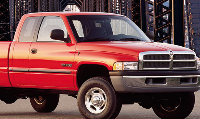timing has to be done when changing Distributor Cap?
#1
I was going to do a tune up on my truck but a guy i know told me if i change the distributor cap and rotor that the timming has to be done any time you change the distributor cap on a dodge truck is that true?or is he just talking out of his hat?Im sure it a good thing to do but you have to do it?
#3
He is talking out of his hat, no matter what make, model, or year vehicle, and regardless of whther the timing is controlled by a computer or not.
Changing just the cap and rotor does nothing to change the timing. That only happens when the body of the distributor is moved so that the position of the rotor moves relative to the position of the cap. (And yes, if you wanted to screw up the timing on your truck by moving the distributor, you could).
Changing just the cap and rotor does nothing to change the timing. That only happens when the body of the distributor is moved so that the position of the rotor moves relative to the position of the cap. (And yes, if you wanted to screw up the timing on your truck by moving the distributor, you could).
#5
Not sure how fuel sync works on these engines.
#7
I couldn't tell you what every electron was doing, but it just seems to me that the PCM expects the dist. cap to be in a certain place, and sends signals to the coil with little regard to its position. To me, that is an effect on ignition timing.
Not sure how fuel sync works on these engines.
Not sure how fuel sync works on these engines.
Well, naturally all the sensors work together(and the pcm figures out what to do with the info it get's from them), but the crank sensor tells the pcm when to fire(spark wise), and the cam sensor tells the pcm when to fire the injectors.
Trending Topics
#8
If the distributor is moved relative to the rotor, how does this not effect when a spark is delivered to a specific cylinder. ("The PCM controls it" won't cut it; I'd like to know exactly how it would know how to deliver the spark so that it arrives at the plug at the same time it would have had the distributor not been moved. I'm not adamantly insisting the the timing changes; just wondering why it doesn't, if in fact it doesn't.
And: If the CMP is strictly for fuel sync, how does the PCM know not to fire the coil on every revolution of the crankshaft? I thought this was one of the functions of the cam sensor/CMP.
#9
The distributor performs 2 functions. You have the cap, rotor and wires that deliver spark to the plugs. Then you have the sensor(pick up coil, cam sensor or whatever one calls it) that tells the pcm when and which injector to pulse/fire. Rotating the dizzy may very well have an effect on (ignition timing), but only because the pcm is seeing something that it needs to correct.
#10
"Then you have the sensor(pick up coil, cam sensor or whatever one calls it) that tells the pcm when and which injector to pulse/fire".
That raises a new question - how does the cam sensor tell the PCM which injector to fire when it's essentially just a switch that goes on and off every 180 degrees of distributor shaft rotation; and leaves another unanswered: how does the PCM know not to fire the coil on every revolution of the crankshft. Again, I thought the CMP controlled that, by telling the PCM that the next cyclinder that needed a spark was TDC of its compression stroke, and not its exhaust stroke.
I just think we all need to understand exactly how this ignition system works, and I just haven't heard what I consider the definitive answer yet.
That raises a new question - how does the cam sensor tell the PCM which injector to fire when it's essentially just a switch that goes on and off every 180 degrees of distributor shaft rotation; and leaves another unanswered: how does the PCM know not to fire the coil on every revolution of the crankshft. Again, I thought the CMP controlled that, by telling the PCM that the next cyclinder that needed a spark was TDC of its compression stroke, and not its exhaust stroke.
I just think we all need to understand exactly how this ignition system works, and I just haven't heard what I consider the definitive answer yet.



